The Universe and Solar System | Term 1 Unit 1 | Geography | 6th Social Science - Exercises Questions with Answers | 6th Social Science : Geography : Term 1 Unit 1 : The Universe and Solar System
Chapter: 6th Social Science : Geography : Term 1 Unit 1 : The Universe and Solar System
Exercises Questions with Answers
Exercises
A. Fill in the blanks.
1. The Universe was formed after Big bang explosion.
2. Light year is
the unit used to measure the distance between two celestial bodies.
3. The Sun is
the centre of the solar system.
4. The word planet means Wandered.
5. Juniter planet has many natural satellites.
6. India’s first ever mission to the moon is Chandrayan-1.
7. Earth is inclined by 23 ½0 N degrees.
8. The Equator faces the Sun directly on 21 march and 23 September.
9. At the time of Perihelion, the Earth is closest to the Sun.
10. The line which divides day and night on the
Earth’s surface is Terminator line.
B. Choose the best
answer.
1. The movement of the Earth on its axis is called
a. Revolution
b. Seasons
c. Rotation
d. Circulation
Answer: c. Rotation
2. The Tropic of
Capricorn faces the Sun directly on
a. March 21
b. June 21
c. September 23
d. December 22
Answer: b. June 21
3. The galaxy in which our solar system is found
is
a. Andromeda
b. Magellanic clouds
c. Milky Way
d. Starburst
Answer: c. Milky Way
4. The only celestial body where man has successfully
landed
a. Mars
b. Moon
c. Mercury
d. Venus
Answer: a. Mars
5. Which of the following planets can float on water?
a. Jupiter
b. Saturn
c. Uranus
d. Neptune
Answer: b. Saturn
C. Circle the odd one out
1. Venus, Jupiter, Neptune,
Saturn
2. Sirius, Andromeda,
Milky way, Magellanic clouds
3. Pluto, Eris, Ceres,
Io
4. Comet, Asteroids,
Meteorites, Dwarf planets
5. Rover, Orbiter, Aeroplane,
Space shuttle
D. Match the following
1. Hottest Planet- a. Mars
2. Ringed Planet- b. Neptune
3. Red Planet- c. Venus
4. Somersaulting Planet- d. Saturn
5. Coldest Planet- e. Uranus
Answer:
1. Hottest Planet - c. Venus
2. Ringed Planet - d. Saturn
3. Red Planet - a. Mars
4. Somersaulting Planet - e. Uranus
5. Coldest Planet - b. Neptune
E. i) Consider the following statements.
1. Venus rotates from
east to west.
2. The Tropic of Cancer
faces the Sun on June 21.
3. Mars has rings around
it.
Choose the correct answer
using the codes given below.
a. 1 and 2
b. 2 and 3
c. 1, 2 and 3
d. 2 only
Answer: a. 1 and 2
ii) Consider the following statements.
Statement I: Earth is called a watery planet.
Statement II: The rotation of the Earth causes seasons.
Which of the statement(s)
is/are true?
a. I is true; II is
wrong
b. I is wrong; II is
true
c. Both the statements
are true
d. Statements I and
II are wrong.
Answer: a. I is true;
II is wrong
F. Name the following
1. Cluster of stars.
galaxy
2. The nearest galaxy to the solar system.
Milky way
3. The brightest planet.
Venus
4. The living sphere.
Earth
5. The year which has 366 days.
Leap year
G. Answer in a sentence or two.
1. Name the inner planets.
Mercury, venus, earth or mars
2. Pluto is no longer a planet. Reason out.
The International
Astronomical Union says, three criteria for a full sized planets.
• It is in orbit
around the Sun.
• It has sufficient
mass to assume hydrostatic equilibrium (a nearly round shape)
• It has “cleared the
neighbourhood” around its orbit.
3. What is perihelion?
Perihelion is the Earth’s closest position to the sun.
4. How many times in a year would you find the Sun
overhead if you lived on 20°N Latitude?
Two times
5. Which celestial body shares its orbit with others?
Give an example.
Pluto which is constrained in its orbit by the gravity
of Neptune and shares its orbital neighbourhood with Kuiper belt.
H. Give reasons.
1. Why is Uranus called
as the somersaulting planet?
It rotates on its axis from east to west like Venus.
Its axis is tilted so much that, it appears to orbit the Sun on its sides like
a rolling ball.
2. The surface of the moon has many craters.
The surface of the moon is characterized by craters
created by the impact of meteors.
3. The velocity of Earth’s rotation is zero at poles.
The velocity of the Earth’s rotation varies from 1670
km per hour at the equator to 845 km per hour at 60° N and S latitudes and zero
at the poles.
I. Answer in detail.
1. Distinguish between inner and outer planets.

Inner planets
• The four planets
nearer to the Sun are called Inner or
Terrestrial Planets.
• The surface of inner
planets has mountains, volcanoes and craters.
• The inner planets
are comparatively smaller in size and are composed of rocks.
• Mercury, Venus,
Earth and Mars
Outer planets
• The last four
planets are called as Outer Planets or
Jovian Planets
• Jupiter, Saturn,
Uranus, and Neptune.
• They are also called
Gaseous Giants.
• An asteroid belt is
found between Mars and Jupiter.
2. What are the effects of rotation and revolution?
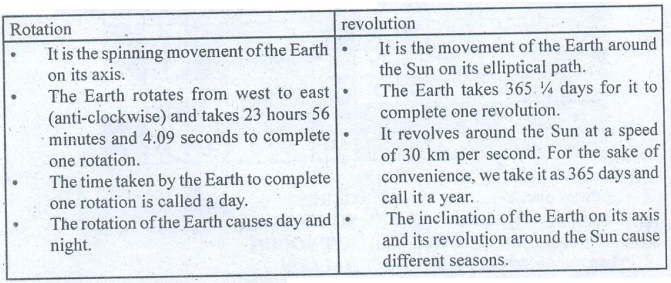
Rotation
• It is the spinning
movement of the Earth on its axis.
• The Earth rotates
from west to east (anti-clockwise) and takes 23 hours 56 minutes and 4.09
seconds to complete one rotation.
• The time taken by
the Earth to complete one rotation is called a day.
• The rotation of the
Earth causes day and night.
Revolution
• It is the movement
of the Earth around the Sun on its elliptical path.
• The Earth takes 365
¼ days for it to complete one
revolution.
• It revolves around
the Sun at a speed of 30 km per second. For the sake of convenience, we take it
as 365 days and call it a year.
• The inclination of
the Earth on its axis and its revolution around the Sun cause different
seasons.
3. Explain the characteristics of the various spheres
of the Earth.
• The Lithosphere is
the land on which we live. It is the solid outer layer of the Earth consisting
of rocks and soils.
• The hydrosphere
consists of water bodies such as oceans, seas, rivers, lakes, ice caps on
mountains and water vapour in the atmosphere.
• Atmosphere is the
envelope of air that surrounds the Earth.
• Biosphere consists
of distinct zones. Each zone has its own climate, plant and animal life. These
zones are known as ecosystems.
J. Picture Study
1. Study the picture and answer the given questions.
a. Which is the closest planet to the Sun?
b. Which is the largest planet?
c. Which is the farthest planet from the Sun?
d. Which is the second smallest planet?
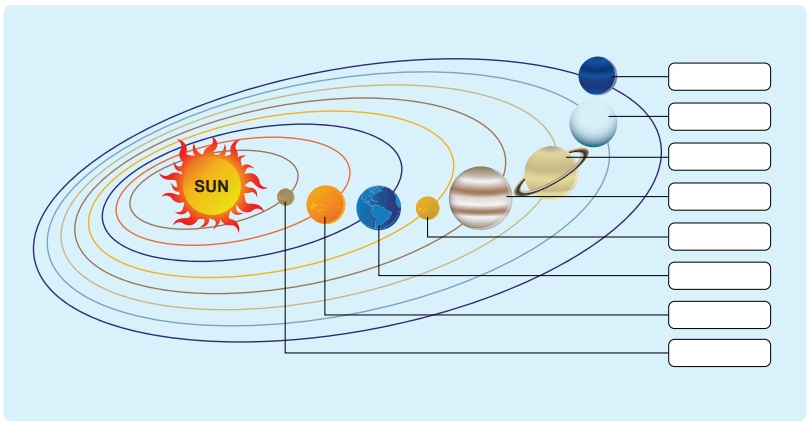
2. Look at the picture and answer the questions
given below
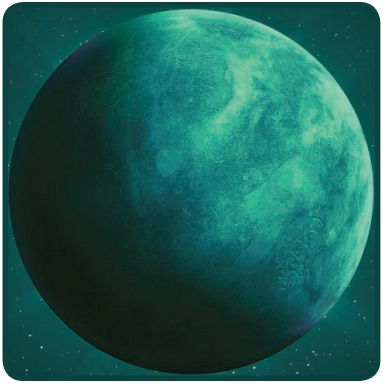
a) Identify the planet
b) What is the colour of the planet?
c) Why is it of this colour?
STUDENT ACTIVITY
K. Solve the puzzle.
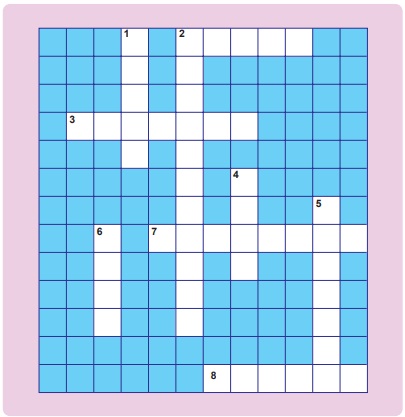
Across
2 A dwarf planet.
3 Equal days and nights.
7 I am a gas found in the Sun.
8 I appear once in 76 years.
Down
1. I am the morning star.
2. India’s first moon mission.
4. I have two natural satellites.
5. I am the farthest planet.
6. An imaginary line passing through the centre
of the Earth.
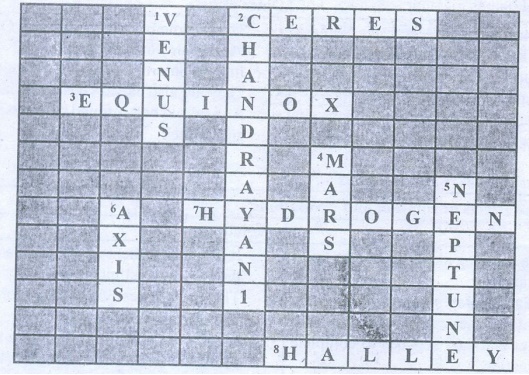
Related Topics